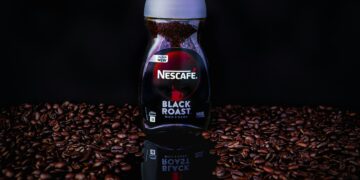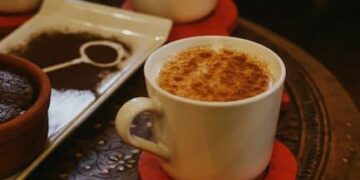Table of Contents
I’m a host.
It’s part of my identity.
I thrive on the hum of conversation in my living room, the clinking of glasses, the shared laughter over a meal I’ve lovingly prepared.
For years, I curated every detail of my gatherings, from the playlist to the placement of the final garnish.
But there was one detail that consistently betrayed me, a final act that often fell crushingly flat: the coffee.
I’ll never forget the brunch.
I call it the “Brunch Catastrophe.” I was hosting my partner’s family for the first time—a high-stakes affair where first impressions felt like everything.
The frittata was fluffy, the scones were buttery, the mimosas were flowing.
All that remained was the coffee, the warm, comforting punctuation mark to a perfect morning.
I had done everything I thought was right.
I’d bought a beautiful, expensive bag of pre-ground coffee from a specialty shop.
I had a brand-new, 12-cup drip machine gleaming on the counter.
I followed the instructions I used for my daily two-cup brew and simply multiplied everything by six.
More coffee, more water.
Simple, right?
Wrong.
As the machine gurgled its last, I poured myself a small, anticipatory cup.
The smell was… off.
Not rich and inviting, but sharp and vaguely burnt.
The taste was worse.
It was a thin, acrid, bitter liquid that bore no resemblance to the delightful brew I made for myself each morning.
It was, in a word, cooked.
My heart sank.
I served it anyway, a forced smile plastered on my face, and watched as my guests took one polite, wincing sip before quietly setting their full mugs aside.1
In that moment, surrounded by my otherwise successful brunch, I felt like a complete failure.
The coffee, meant to be a gesture of warm hospitality, was an insult.
That failure sent me down a rabbit hole.
I was determined to understand why my coffee was so bad.
I read blogs, watched videos, and tinkered with variables, but my results remained wildly inconsistent.
The common advice—use good beans, use the right ratio—wasn’t enough.
It was clear I was missing a fundamental piece of the puzzle.
The problem wasn’t just my recipe; it was my entire philosophy.
I had assumed that making more coffee was a simple act of multiplication, a linear scaling of a small process.
But the physics of brewing don’t work that Way. As I would soon learn, when you make a bigger batch of coffee, you can’t just double the ingredients and expect the same result.
The extra time it takes for all that water to drain through the larger bed of grounds is enough to over-extract the coffee, leaving you with a dull, bitter, and deeply unsatisfying brew.3
My method was doomed from the start because it failed to account for the systemic shift required when scaling up.
Part 1: The Epiphany – Trading My Apron for a Soundboard
My breakthrough didn’t come from a coffee blog or a barista tutorial.
It came, bizarrely, from watching a documentary about the sound engineers at a massive music festival.
I watched, fascinated, as an engineer sat behind a colossal mixing console, a galaxy of knobs and faders at their fingertips.
Their job was to take dozens of individual sound sources—a booming kick drum, a shimmering cymbal, a raw vocal, a crunchy guitar—and blend them into a single, cohesive, powerful musical experience for an audience of 100,000 people.4
They weren’t just making things louder.
They were shaping, sculpting, and balancing.
They were managing a complex system in real-time to create clarity from chaos.
And in that moment, it clicked.
A powerful, clarifying analogy struck me with the force of a thunderclap: Making great coffee for a crowd is not like baking a bigger cake; it’s like mixing a live concert.
This single idea changed everything.
It reframed the entire problem.
I had been acting like a baker, rigidly following a recipe and hoping for the best.
I needed to start thinking like a sound engineer, actively managing a dynamic system.
A recipe is static, but a live performance—and a large batch of coffee—is a living thing, subject to countless variables like ambient temperature, humidity, and the specific characteristics of your equipment.6
The failure of my brunch wasn’t a failure of ingredients; it was a failure of engineering.
The world of live sound gave me a new language and a new framework to understand coffee.
Suddenly, the disparate tips and tricks I’d been reading snapped into a coherent system.
I realized that to conquer group coffee, I needed to master four key concepts from the audio world:
- Gain Staging: Setting the perfect input level for every instrument to ensure a clean, strong signal from the very start.
- Equalization (EQ): Surgically shaping the tone of each instrument so it sounds its best and fits perfectly in the mix.
- The Crossover Network: Splitting the sound into different frequency bands and sending them to specialized speakers (subwoofers, tweeters) for ultimate clarity.
- The Final Mix & Monitoring: Combining everything into a polished final product for the audience and ensuring the performers on stage can hear everything perfectly.
This wasn’t just a cute metaphor.
It was a new paradigm.
It was a system that transformed me from a frustrated recipe-follower into a confident system-manager.
It gave me the tools not just to make good coffee for a group, but to do it consistently, reliably, and with the calm, focused control of a professional at the mixing board.
Part 2: Gain Staging – Setting Your Inputs for a Flawlessly Clean Brew
In the world of live sound, everything starts with gain staging.
Before a single fader is pushed, the engineer must set the input level, or “gain,” for every microphone and instrument on stage.
The goal is to capture a signal that is as strong and clean as possible, right from the source.
If the gain is set too low, the signal is weak and full of background hiss; when you turn it up later, you just amplify the noise.
If the gain is set too high, the signal “clips,” creating a harsh, ugly distortion that no amount of fancy mixing can fix.8
A great final mix is impossible without great gain staging.
The same is true for coffee.
You cannot fix a bad start.
The “gain staging” phase of coffee brewing is about meticulously preparing your three core inputs—the beans, the water, and the ratio—to ensure the signal you send to your brewer is strong, clean, and free of distortion.
This is where 90% of home coffee for a crowd goes wrong.
Input 1: The Beans (The Microphone)
Your coffee beans are your lead vocalist’s microphone.
If the mic is cheap, damaged, or old, the performance will sound flat, muffled, and lifeless, no matter how talented the singer or how expensive the sound system.
- Freshness is Paramount: Using stale beans is the number one mistake in coffee brewing.10 Coffee beans are an agricultural product, and their flavor peaks and then degrades. Once roasted, they begin to oxidize, and this process accelerates dramatically once they are ground.10 The ideal window for peak flavor is generally between four days and four weeks after the roast date, which should be printed on the bag.13 Pre-ground coffee, no matter how well-packaged, has lost the majority of its aromatic compounds and volatile oils by the time it reaches you. Using it is like trying to record a symphony with a microphone wrapped in a sock. The signal is weak from the start.
- Quality and Roast: Just as microphones have different characteristics, so do beans. The origin, processing method, and roast level determine the fundamental “timbre” of your coffee.14 For a crowd, a medium roast is often a crowd-pleasing choice, offering a balance of acidity, body, and sweetness.
- Proper Storage: Once you have your high-quality “microphone,” you must protect it. The enemies of coffee are oxygen, moisture, heat, and light.13 Store your whole beans in an airtight, opaque container in a cool, dark place like a pantry. Never, ever store them in the freezer; the moisture can damage the beans’ cellular structure and flavorful oils.16
Input 2: The Water (The Amplifier’s Power)
Water makes up over 98% of your final cup, making it the amplifier that powers your entire system.17
If your amplifier provides unstable, “dirty,” or insufficient power, your sound will be distorted and weak.
- Temperature is Power: The single most critical variable in coffee extraction is water temperature. The Specialty Coffee Association (SCA) has determined that the optimal temperature range for brewing is between 195°F and 205°F (90.6°C to 96.1°C).10 This is the “clean power” your system needs.
- Water Too Hot (>205°F): This is like an overdriven amplifier. It “clips” the coffee signal, aggressively stripping out unwanted bitter and astringent compounds. The result is a harsh, burnt, and bitter cup.12 This is a common failure of cheap drip machines that simply boil the water without regulation.20
- Water Too Cool (<195°F): This is like an underpowered amplifier. It doesn’t have enough energy to properly extract all the desirable sugars and acids from the coffee. The result is a weak, sour, and underdeveloped cup—a “noisy” signal.12 This is the other major flaw of most consumer-grade coffee makers; they simply cannot get the water hot enough to do the job.22
- Water Quality is Cleanliness: Using straight tap water is like plugging your expensive audio gear into a faulty electrical outlet with a bad ground hum. Chlorine will give your coffee a chemical taste, while excessive mineral content (hard water) can lead to bitter extraction and scale buildup that damages your machine.12 For a “clean” signal, always use filtered water. Avoid distilled water, as it lacks the necessary minerals for proper extraction.17
Input 3: The Ratio (The Channel Fader)
Once you have a clean signal from your mic (beans) and clean power from your amp (water), you need to set the level.
The coffee-to-water ratio is your channel fader, determining the final strength and balance of the brew.
- Use Weight, Not Volume: Using scoops to measure coffee is like setting a fader by eye. It’s wildly inconsistent. Depending on the bean’s density and grind size, a scoop can hold vastly different amounts of coffee from day to day.10 A sound engineer would never guess at a level; they use the precise markings on the fader. Your tool for this precision is a digital kitchen scale. Weighing both your coffee and your water is the only way to achieve repeatable, consistent results.
- The Golden Ratio: The industry-standard starting point, often called the “Golden Ratio,” is approximately 1 part coffee to 16 parts water by weight (e.g., 60 grams of coffee for 1000 grams/milliliters of water).12 Think of this as the “Unity” or “0 dB” mark on a fader—the baseline for a perfectly balanced signal. From here, you can adjust slightly to your personal taste (e.g., 1:15 for a stronger brew, 1:17 for a lighter one), but 1:16 is your rock-solid starting point.
By meticulously controlling these three inputs, you are performing perfect gain staging.
You are ensuring that the signal going into your brewer is as good as it can possibly be, setting yourself up for a fantastic final mix.
| The Host’s Coffee Gain Staging Cheat Sheet | |||
| Input | The Audio Analogy | Ideal Parameter | The “Why” (Consequence of Failure) |
| Coffee Beans | The Microphone / Source Signal | Whole beans, roasted 4-28 days ago. Stored in an airtight, dark container. | Using stale/pre-ground beans is like using a broken microphone. The signal is weak and flat, resulting in tasteless coffee no matter how good the rest of your gear is.10 |
| Water | The Amplifier / Power Supply | Filtered water heated to 195-205°F (90-96°C). | Water that’s too hot “clips” the signal, causing bitterness. Water that’s too cool creates a weak, “noisy” signal, causing sourness. Bad water quality introduces unwanted flavors.12 |
| Ratio | The Channel Fader | ~1:16 coffee-to-water ratio, measured by weight (grams) on a digital scale. | Measuring by volume (scoops) is inconsistent and unreliable. An incorrect ratio leads to a brew that is either too weak (under-extracted) or too strong and bitter (over-extracted).10 |
Part 3: The Art of EQ – Using Your Grinder to Shape the Perfect Flavor Profile
After setting the gain, a sound engineer turns to the Equalizer, or EQ.
This is arguably the most powerful tool on the mixing console.
EQ allows an engineer to sculpt the tonal character of each instrument with surgical precision.
They can cut the “boxy” or “muddy” frequencies from a vocal to make it clear and present, boost the shimmering “air” in a cymbal to make it sparkle, or carve out a space in the low-mids of a guitar to keep it from clashing with the bass.8
A good EQ job makes every element in the mix sound not just good, but like the best version of itself.
For the home host, your most important EQ tool is your coffee grinder.
The grinder is your equalizer. The size and consistency of your coffee grounds are the primary factors that determine which flavor compounds are extracted and at what rate.
Adjusting your grind is how you shape the final flavor profile of your coffee.
Your Grinder as a Parametric EQ
A cheap blade grinder is a sledgehammer.
It doesn’t grind; it smashes beans into a chaotic mix of boulders and dust.
This inconsistency makes even extraction impossible, resulting in a cup that is simultaneously sour (from the under-extracted boulders) and bitter (from the over-extracted dust).
It is the audio equivalent of a broken EQ knob that you can only turn to “mud” or “ice pick.”
A quality burr grinder, however, is a precision tool.
It uses two revolving abrasive surfaces (burrs) to crush beans into a uniform and consistent size.
By adjusting the distance between these burrs, you gain precise control over your coffee’s “EQ.”
- Grind Too Coarse (Under-Extracted): When the grind is too coarse, water flows through the coffee bed too quickly. It doesn’t have enough time or surface area to extract the sweet, complex flavor compounds. It only manages to pull out the fast-extracting acids. This is like cutting too many high and mid frequencies from your sound, leaving you with a dull, lifeless mix. The coffee tastes sour, weak, thin, and “tea-like”.12
- Grind Too Fine (Over-Extracted): When the grind is too fine, the water flow is choked. The extended contact time pulls out everything—the good, the bad, and the ugly. After extracting the desirable acids and sugars, it starts pulling out the bitter, dry, and astringent compounds. This is like boosting the high frequencies into the stratosphere, creating a sound that is harsh, sibilant, and painful to listen to. The coffee tastes bitter, pungent, and hollow.12
- The “Sweet Spot” Grind: Finding the right grind size for your specific beans and brew method is the art of EQ. It creates a balanced extraction where the water has just enough time to pull out all the desirable sweetness and complexity without veering into sour or bitter territory. This allows the coffee’s unique origin flavors—its “timbre”—to shine through with clarity and definition.
This understanding leads to one of the most crucial, and often counter-intuitive, pieces of advice for anyone looking to improve their coffee game: your grinder is more important than your brewer. Many people invest in a fancy, expensive coffee maker while using pre-ground coffee or a cheap blade grinder.
This is fundamentally backward.
A top-of-the-line, SCA-certified brewer can guarantee perfect water temperature and brew time, but it cannot fix a flawed input.
If the grind is inconsistent, the extraction will be uneven, period.
You cannot use a world-class mixing console to fix a recording made with a broken microphone.
A modest but competent brewer paired with an excellent burr grinder will produce a vastly superior cup of coffee than the reverse.
The single most impactful upgrade you can make to your coffee “sound system” is a quality burr grinder.
Building Your Grinder Arsenal (Your EQ Rack)
Choosing a grinder is like choosing the EQ for your studio.
You can start with a basic, reliable unit or invest in a more advanced model with finer controls.
For serving groups, you also need to consider the hopper capacity—how many beans it can hold at once.
- Entry-Level (The 3-Band EQ): These grinders are the reliable workhorses. They offer enough adjustment to dial in a great cup for drip or French press and represent a massive leap in quality from a blade grinder.
- Baratza Encore ESP: Often cited as the best entry-level electric grinder, the Encore is durable, reliable, and backed by excellent customer service that provides replaceable parts, so it’s designed to be repaired, not thrown away.25 The “ESP” model offers an expanded range for both filter coffee and entry-level espresso, making it a versatile starting point.28
- OXO Conical Burr Grinder: Known for its user-friendly design and solid performance at a sub-$100 price point, the OXO delivers excellent grind consistency for its class. It has a large hopper that can hold up to 12 ounces (3/4 lb) of beans, making it convenient for grinding for a group.25
- Prosumer (The Graphic EQ): For the host who wants more control and is brewing for a discerning crowd, these grinders offer more settings (more “bands” on your EQ) and even greater consistency.
- Breville Smart Grinder Pro: A perennial favorite, this grinder boasts 60 distinct grind settings, giving you immense control. It has a digital interface and dosing options that make it feel like a professional tool. Its large hopper and portafilter cradle also make it a capable entry-level espresso grinder.25
- Fellow Opus: A stylish and modern option, the Opus offers over 41 settings and is designed for single-dosing, which is great for freshness. While praised for the quality of coffee it produces, some users find its adjustment mechanism less intuitive than other models.25
- Integrated Grind & Brew (The All-in-One Channel Strip): For ultimate convenience without sacrificing quality, some machines combine a burr grinder and a brewer. This is like having a high-quality preamp and EQ built into one console channel.
- Cuisinart Burr Grind & Brew 12-Cup (DGB-800): These models feature a built-in burr grinder and an 8-ounce bean hopper, automatically grinding the correct amount of coffee for the number of cups you select. This is an excellent solution for streamlining the process of making coffee for a crowd.33
- Capresso CoffeeTEAM GS: This machine uses solid steel conical burrs and has a 6-ounce bean container, enough for 20 cups of brewed coffee depending on the strength setting. It allows you to program the grind amount for 2 to 10 cups.35
| The Host’s Grinder Arsenal (Your EQ Rack) | ||||
| Grinder Model | Price Tier | Hopper Capacity | Best For | The “EQ” Analogy |
| Baratza Encore ESP | Budget/Enthusiast | 8 oz (227 g) | All-around filter brewing, entry-level espresso | A reliable 40-band graphic EQ. The industry standard for getting precise, consistent results without breaking the bank.25 |
| OXO Conical Burr Grinder | Budget | 12 oz (340 g) | Drip, French Press, Cold Brew | A user-friendly 15-band EQ with micro-adjustments. Simple, effective, and gets the job done with clarity and a large capacity.29 |
| Breville Smart Grinder Pro | Enthusiast | 18 oz (1 lb) | All-around brewing, excels at fine-tuning | A 60-band digital parametric EQ. Offers immense control for the host who wants to surgically dial in the perfect flavor for any bean or brew method.25 |
| Cuisinart Grind & Brew (DGB-800) | Enthusiast | 8 oz (227 g) | Maximum convenience for groups | An all-in-one channel strip. Combines a solid EQ with the brewer, streamlining your workflow from input to output.33 |
Part 4: The Crossover Network – The Secret to Clarity in Large Batches
Here we arrive at the heart of the paradigm—the solution to the very problem that started this journey.
In a large concert setting, you can’t just point a single, small speaker at a stadium and turn it up.
The result would be a distorted, muddy catastrophe.
Instead, engineers use a device called a crossover.
A crossover takes the full-range audio signal and splits it into different frequency bands.
The deep, rumbling bass frequencies (below ~100 Hz) are sent exclusively to giant subwoofers designed to handle them.
The critical mid-range frequencies are sent to mid-range drivers, and the crisp, clear high frequencies are sent to tweeters or horns.4
This division of labor is the secret to power and clarity.
Each speaker component operates in its most efficient range, free from the burden of trying to reproduce frequencies it wasn’t designed for.
The combined output is a clean, detailed, and powerful sound that fills the entire venue.
This is the Crossover Method, and it is the key to making fantastic coffee for a group.
The Problem with a Single Large Batch
My brunch catastrophe was a perfect example of trying to push a full-range signal through a single tweeter.
When you brew a single, massive 12-cup pot of coffee, you create a very deep bed of coffee grounds.
As the water tries to pass through this dense bed, the brew time becomes dramatically extended.3
The grounds at the top of the filter get hit with water first and for the longest, becoming severely over-extracted and bitter.
The grounds at the bottom might not get fully saturated, leading to under-extraction and sourness.
You are creating a “distorted” and “muddy” cup, where distinct flavors are lost in a muddle of bitter and sour notes.3
The very design of most large-capacity home brewers, with their wide, flat-bottomed filter baskets, practically guarantees this uneven extraction.
The Solution: The Crossover Method
The solution is to stop thinking in terms of one big batch and start thinking like a sound engineer dividing the signal.
Instead of brewing one flawed 12-cup pot, you apply the Crossover Method: brew multiple, smaller, perfectly optimized batches and combine them.
For example, to serve 12 cups of coffee:
- Pre-heat a large thermal carafe with boiling water. This is non-negotiable and acts as your “summing bus,” the place where all your clean signals will be combined.
- Brew a 6-cup batch using the perfect grind and ratio for that specific batch size. This is your “mid-range” signal. Because it’s a smaller batch, the water will flow through at the optimal speed, ensuring a beautiful, even extraction.
- Pour the finished coffee into the pre-heated thermal carafe.
- Immediately brew a second 6-cup batch using the exact same parameters. This is your “high-frequency” signal.
- Add this second batch to the thermal carafe.
The result in your carafe is a “full-spectrum” coffee that is the sum of two perfectly extracted parts.
It is clear, balanced, vibrant, and delicious.
You have bypassed the physics problem of the single large batch by breaking it down into manageable components.
This approach is championed by coffee experts like Scott Rao, who consistently advocate for cafes to use smaller, more frequent batch brews to maximize quality and freshness.37
This method does require a few more minutes of active work than pressing a single button, but it reveals the hidden trade-off in home coffee equipment.
The “convenience” of a one-touch 12-cup brewer comes at the direct and immense cost of quality.
The Crossover Method redefines convenience not as “fewer steps” but as “a reliable, stress-free process that produces a result you are proud to serve.” It eliminates the risk and anxiety of serving bad coffee, which is the ultimate convenience for any host.
Alternative Crossover Strategy: The Cold Brew Concentrate
For an even more stress-free approach, especially for large parties or gatherings on a hot day, you can prepare a cold brew concentrate in advance.
This is another form of the Crossover Method.
Cold brew is made by steeping coarse grounds in cold water for 12-24 hours.
The resulting liquid is a smooth, low-acid, and very stable coffee concentrate.3
- The Concentrate is your Subwoofer: It’s the deep, smooth, powerful bass frequency of your mix. You can make a large batch of this days in advance and store it in the fridge.
- Hot Water is your Tweeter: When it’s time to serve, you simply mix the concentrate with hot water (or cold water and ice). For a group, you can have a large thermal carafe of hot water ready next to your pitcher of concentrate.
- The Mix: Guests can customize the strength of their own cup. This method is incredibly scalable, forgiving, and removes almost all of the day-of-event stress from the coffee equation.3
Part 5: The Final Mix and Presentation – Delivering a Flawless Show
The concert is about to begin.
The gain is staged, the EQs are set, and the crossovers are routing the signals.
Now, the engineer has two final jobs.
First, they create the Front of House (FOH) mix—the final, polished sound the audience hears.
Second, they create the monitor mix—the custom sound mix sent back to the musicians on stage so they can hear themselves and each other clearly.5
A great FOH mix is useless if the band can’t perform because their monitor mix is a mess.
For the host, this final stage is about temperature management (your monitor mix) and creating a beautiful, inviting coffee station (your FOH mix).
Temperature Management (The Monitor Mix)
A band can’t give a great performance if they can’t hear themselves properly.
Likewise, your perfectly brewed coffee can’t “perform” if it’s not served at the right temperature.
- The Evil of the Hot Plate: The warming plate found on most glass-carafe coffee makers is the single most destructive feature in home coffee brewing. It is a terrible monitor mix. It doesn’t just keep the coffee warm; it actively cooks it, continuously applying heat that breaks down the delicate aromatic and flavor compounds. Within 30 minutes, a beautiful brew can be turned into a bitter, stewed mess.38
- The Heroism of the Thermal Carafe: A high-quality, double-walled, vacuum-insulated thermal carafe is the audio engineer’s dream monitor. It is passive. It adds no extra heat. It simply preserves the coffee at its perfect serving temperature—ideally between 176°F and 185°F (80°C and 85°C)—for hours.18 This allows the flavor profile you worked so hard to create to remain intact. When serving coffee to a group over any length of time, a thermal carafe is not a luxury; it is an absolute necessity. Remember to always pre-heat the carafe by filling it with boiling water for a few minutes before you start brewing; a cold carafe will instantly sap heat from your coffee.12
The Coffee Bar (The FOH Mix & Effects Rack)
This is the final presentation for your “audience”—your guests.
A well-appointed, self-serve coffee bar is your FOH mix.
It’s where you add the final polish and give your guests the “effects rack” to customize their own experience.
- The Setup: Arrange your thermal carafes, cups, and accoutrements in an inviting and logical way.43
- The “Effects”:
- Provide a selection of milks and creamers. For an extra touch, gently warm the milk before serving so it doesn’t drastically cool down the coffee.38
- Offer a variety of sweeteners: sugar cubes, raw sugar, simple syrup, etc.
- Use quality ceramic mugs. The material of the cup affects heat retention and the overall sensory experience.38 Pre-warming the mugs with hot water is a pro move that makes a huge difference.12
- Signage: If you’re serving multiple types of coffee (e.g., regular, decaf) or have a carafe of hot water for tea or Americanos, use clear, simple labels. This is like labeling the channels on your mixing board—it prevents confusion and makes for a smooth show.46
Your Mixing Console (The Brewer)
The final piece of your system is the brewer itself—your mixing console.
Now that you understand the entire system, you can see that the brewer’s primary job is to execute the fundamentals of gain staging flawlessly: it must heat water to the correct temperature (195-205°F) and deliver it to the coffee grounds for the correct amount of time (4-8 minutes).18
This is why SCA-Certified Home Brewers are the gold standard.
The Specialty Coffee Association runs a rigorous testing program, and only brewers that can meet these strict requirements for temperature, time, and evenness of extraction earn the certification.18
Choosing an SCA-certified brewer is like choosing a mixing console from a reputable brand; you know it’s built to professional specifications.
- The Reliable Workhorse (The Analog Console): Technivorm Moccamaster. Handmade in the Netherlands, Moccamasters are legendary for their durability, iconic design, and, most importantly, their ability to hit and hold the perfect brewing temperature with unwavering consistency. They are simple, powerful, and built to last a lifetime, and nearly all models come with an excellent thermal carafe.48
- The Customizable Powerhouse (The Digital Console): Breville Precision Brewer. For the host who wants ultimate control, the Breville Precision Brewer is a digital marvel. It allows you to adjust temperature, flow rate, and bloom time, and even has presets for Gold Cup, Iced, and Cold Brew. It’s a highly versatile machine that lets you fine-tune every aspect of your brew.51
- The Best Value Champions (The High-Quality Portable Mixer): Bonavita & Ninja. Brands like Bonavita and Ninja offer several SCA-certified models that deliver exceptional performance at a more accessible price point. The Bonavita Connoisseur is a long-time favorite for its simplicity and excellent thermal carafe.50 The Ninja Specialty Coffee Maker offers incredible versatility, with multiple brew sizes and a built-in milk frother, making it a fantastic all-in-one station.48
| The Rockstar Barista’s Rig (Your Complete Sound System) | |||
| Component | Budget Pick | Enthusiast Pick | Pro-Host Pick |
| The Brewer (Mixing Console) | Bonavita Connoisseur 8-Cup 50 | Technivorm Moccamaster KBGT 48 | Breville Precision Brewer 51 |
| Why it Fits the System: | Delivers SCA-certified temperature and a great thermal carafe at an unbeatable price. | The industry standard for consistent, reliable “power” and a flawless “monitor mix” via its thermal carafe. | A fully digital console offering ultimate control over every variable in your “mix.” |
| The Grinder (EQ Rack) | OXO Conical Burr Grinder 29 | Baratza Encore ESP 28 | Breville Smart Grinder Pro 25 |
| Why it Fits the System: | A user-friendly EQ with a large hopper, providing the essential grind consistency needed for clear flavor. | A versatile and repairable graphic EQ that gives you precise control for dialing in any filter brew. | A high-resolution parametric EQ with 60 settings for surgical flavor sculpting and a massive hopper for big events. |
| The Server (Summing Bus) | WhiteRhino 68oz Thermal Carafe 53 | Zojirushi Fresh Brew Plus 42 | Bunn 3.0L Lever-Action Airpot 54 |
| Why it Fits the System: | An affordable, large-capacity way to combine your “crossover” batches and maintain temperature. | A high-performance carafe from a brand renowned for insulation technology. | For large-scale events, an airpot provides massive capacity and easy, insulated dispensing for your FOH mix. |
Conclusion: Taking the Stage as a Confident Host
I think back to the Brunch Catastrophe, to the feeling of sinking disappointment as I watched those full mugs of coffee grow cold.
The host in me, the person who finds joy in caring for others, felt defeated.
I was armed with good intentions and expensive ingredients, but I lacked a system.
I was a musician with a great song but no understanding of how to make it sound good for an audience.
Today, things are different.
The “Live Sound System for Coffee” has become my trusted framework.
When I plan a gathering now, the coffee is no longer a source of anxiety but a point of pride.
I see my kitchen counter not as a cooking space, but as a production booth.
I lay out my “gear”: my burr grinder (my EQ), my digital scale (my fader), my SCA-certified brewer (my console), and my pre-heated thermal carafe (my summing bus).
I perform my sound check, dialing in the grind for the beautiful, freshly roasted beans (my microphone).
I ensure my water is filtered and at the perfect temperature (my clean power).
I weigh my inputs with precision (my gain staging).
And then, I execute the Crossover Method, brewing two perfect, smaller batches back-to-back, combining them into a single, glorious, full-spectrum pot of coffee that I know is balanced, clear, and delicious.
The result is more than just great coffee.
It’s the confidence that comes from mastery.
It’s the quiet joy of watching a guest’s eyes light up after their first sip.
It’s the transformation of a point of stress into an act of creative expression.
This system isn’t about becoming a coffee snob or obsessing over minutiae for its own sake.
It’s about taking control, understanding the “why” behind the “how,” and trading frantic guesswork for calm, repeatable excellence.
It’s about stepping up to the mixing board of your own kitchen and knowing, with absolute certainty, that you’re about to deliver an amazing show.
Works cited
- What’s your best “coffee fail” story? – Reddit, accessed August 4, 2025, https://www.reddit.com/r/Coffee/comments/ns8f04/whats_your_best_coffee_fail_story/
- What’s the biggest “coffee” mistake you’ve ever made? – Reddit, accessed August 4, 2025, https://www.reddit.com/r/Coffee/comments/kkr07h/whats_the_biggest_coffee_mistake_youve_ever_made/
- 4 Effective Ways To Brew Coffee For Big Groups – JavaPresse, accessed August 4, 2025, https://www.javapresse.com/blogs/enjoying-coffee/brew-coffee-for-big-groups
- Live Sound Engineering: What You Need to Start – Berklee Online Take Note, accessed August 4, 2025, https://online.berklee.edu/takenote/live-sound-engineering-what-you-need-to-start/
- Live Sound Mix Engineer – Berklee College of Music, accessed August 4, 2025, https://www.berklee.edu/careers/roles/live-sound-engineer
- Coffee inconsistent from day to day with same technique – Reddit, accessed August 4, 2025, https://www.reddit.com/r/Coffee/comments/194v9ii/coffee_inconsistent_from_day_to_day_with_same/
- How can you ensure batch-to-batch consistency when roasting coffee? – Perfect Daily Grind, accessed August 4, 2025, https://perfectdailygrind.com/2021/09/how-can-you-ensure-batch-to-batch-consistency-when-roasting-coffee/
- Sound Engineering Skills 101: The Ultimate Guide for Beginners, accessed August 4, 2025, https://robsummers.co.uk/sound-engineering-skills/
- The Complete Guide to the Basics of Live Sound — Pro Audio Files, accessed August 4, 2025, https://theproaudiofiles.com/complete-guide-basics-live-sound/
- 7 Mistakes You’re (Probably) Making While Brewing Coffee, accessed August 4, 2025, https://www.gridlockcoffee.com.au/blog/coffee-brewing-mistakes/
- Stop! 11 Coffee Brewing Mistakes You Make Daily, accessed August 4, 2025, https://fnb.coffee/blog/coffee-brewing-mistakes/
- Troubleshooting Your Coffee: Common Brewing Mistakes and How to Fix Them, accessed August 4, 2025, https://www.mochasandjavas.com/troubleshooting-your-coffee-common-brewing-mistakes-and-how-to-fix-them/
- 10 Common Coffee Brewing Mistakes You Might Be Making, accessed August 4, 2025, https://beannbeancoffee.com/blogs/beansider/10-common-coffee-brewing-mistakes-you-might-be-making
- Why Does Coffee Taste Bad to Me Suddenly? Complete Guide to Causes & Solutions, accessed August 4, 2025, https://www.kimbocoffee.com/blogs/kimbo-blog/why-does-coffee-taste-bad-to-me-suddenly
- Coffee Tastes Bad? Here’s How to Fix It – Jake’s Convenience, accessed August 4, 2025, https://www.jakescave.com/post/coffee-tastes-bad-here-s-how-to-fix-it
- What coffee brewing mistakes do beginners make?, accessed August 4, 2025, https://hugo.coffee/coffee-brewing-mistakes/
- Why Does My Coffee Taste Weak? – Philly Fair Trade Roasters, accessed August 4, 2025, https://phillyfairtrade.com/blogs/learn/why-does-my-coffee-taste-weak
- Certified by the SCA: Moccamaster and the Golden Cup Standard, accessed August 4, 2025, https://us.moccamaster.com/blogs/blog/certified-by-the-sca-moccamaster-and-the-golden-cup-standard
- Troubleshooting Common Coffee Brewing Problems: 5 Key Factors – Cartel Roasting Co, accessed August 4, 2025, https://cartelroasting.co/troubleshooting-a-brew/
- How did American’s love of percolated drip coffee come about? – Reddit, accessed August 4, 2025, https://www.reddit.com/r/Coffee/comments/s6s3kf/how_did_americans_love_of_percolated_drip_coffee/
- How do coffee percolators work? How does the water get forced up the tube? – Quora, accessed August 4, 2025, https://www.quora.com/How-do-coffee-percolators-work-How-does-the-water-get-forced-up-the-tube
- Why does drip coffee taste so weak? – Reddit, accessed August 4, 2025, https://www.reddit.com/r/Coffee/comments/hj6wxw/why_does_drip_coffee_taste_so_weak/
- [Serious] What’s wrong with drip coffee? – Reddit, accessed August 4, 2025, https://www.reddit.com/r/Coffee/comments/1qwf7m/serious_whats_wrong_with_drip_coffee/
- Why Does My Coffee Taste Bad?, accessed August 4, 2025, https://www.seattlecoffeegear.com/blogs/scg-blog/why-does-my-coffee-taste-bad
- The 6 Best Burr Coffee Grinders for Every Brew Style, Budget and Bean – Taste of Home, accessed August 4, 2025, https://www.tasteofhome.com/collection/best-burr-coffee-grinders/
- 13 Best Coffee Grinders 2025 | The Strategist – New York Magazine, accessed August 4, 2025, https://nymag.com/strategist/article/best-coffee-grinders.html
- Wanted: Quality grinder at (relatively) affordable price : r/Coffee – Reddit, accessed August 4, 2025, https://www.reddit.com/r/Coffee/comments/ygj3gt/wanted_quality_grinder_at_relatively_affordable/
- The 9 Top Burr Coffee Grinders of 2024 | No BS* Guide & Reviews, accessed August 4, 2025, https://coffeechronicler.com/gear/grinders/
- We Tested 19 Coffee Grinders to Find the Best Ones for Drip, Espresso, Pour-Over, and More – Serious Eats, accessed August 4, 2025, https://www.seriouseats.com/the-best-coffee-grinders
- 12-Cup Coffee Maker with Podless Single-Serve Function & Conical Burr Coffee Grinder Bundle – OXO, accessed August 4, 2025, https://www.oxo.com/12-cup-coffee-maker-with-podless-single-serve-function-conical-burr-coffee-grinder-bundle.html
- Best Budget Coffee Grinders for 2025 – CoffeeGeek, accessed August 4, 2025, https://coffeegeek.com/guides/feature-guides/best-budget-coffee-grinders-for-2025/
- The Best Espresso Grinder Under £250 – YouTube, accessed August 4, 2025, https://www.youtube.com/watch?v=G7xGhGtvYIs
- Cuisinart Burr Grind & Brew 12 Cup Automatic Coffee Maker – Costco Wholesale, accessed August 4, 2025, https://www.costco.com/cuisinart-burr-grind-%2526-brew-12-cup-automatic-coffee-maker.product.100490264.html
- Cuisinart Burr Grind & Brew 12 Cup Coffee Maker Black/Stainless DGB-800 – Best Buy, accessed August 4, 2025, https://www.bestbuy.com/site/cuisinart-burr-grind-brew-12-cup-coffee-maker-black-stainless/6258429.p?skuId=6258429
- CoffeeTEAM GS Coffee Maker/Conical Burr Grinder Capresso, accessed August 4, 2025, https://www.capresso.com/coffeeteam-gs.html
- Understanding and using live sound equipment | The Tone Rooms, accessed August 4, 2025, https://www.thetonerooms.com/threads/understanding-and-using-live-sound-equipment.18404/
- There Are No Points for Difficulty in Coffee – Scott Rao, accessed August 4, 2025, https://www.scottrao.com/blog/there-are-no-points-for-difficulty-in-coffee
- Hot Tips How to Make Your Coffee Hot and Keep It That Way – JavaPresse, accessed August 4, 2025, https://www.javapresse.com/blogs/enjoying-coffee/hot-tips-how-to-make-your-coffee-hot-and-keep-it-that-way
- Does coffee from a large coffee machine taste worse than from a small one? – Quora, accessed August 4, 2025, https://www.quora.com/Does-coffee-from-a-large-coffee-machine-taste-worse-than-from-a-small-one
- Why drip coffee makers might be ruining your coffee, accessed August 4, 2025, https://mill47.coffee/blogs/take2/why-drip-coffee-makers-might-be-ruining-your-coffee
- How to Keep Coffee Hot While Traveling in Winter – OutIn, accessed August 4, 2025, https://outin.com/blogs/news/keep-coffee-hot-winter
- The Best Thermal Carafe Coffee Makers, Tested & Reviewed – The Spruce Eats, accessed August 4, 2025, https://www.thespruceeats.com/best-thermal-carafe-coffeemakers-4155216
- 8 Coffee Recipes for Entertaining House Guests | by Style My Soul * StyleMySoul.com, accessed August 4, 2025, https://medium.com/@stylemysoul/8-coffee-recipes-for-entertaining-house-guests-c431b076b76f
- How to Host an At-Home Café: Easy Tips for a Cozy Gathering, accessed August 4, 2025, https://camillestyles.com/entertaining/at-home-cafe/
- How to keep coffee hot? : r/ask – Reddit, accessed August 4, 2025, https://www.reddit.com/r/ask/comments/1houb62/how_to_keep_coffee_hot/
- Coffee for a Crowd – Cook Like a Caterer, accessed August 4, 2025, http://cooklikeacaterer.com/blog/2019/9/14/coffee-for-a-crowd
- SCA Certified Home Brewer Program – Specialty Coffee Association, accessed August 4, 2025, https://sca.coffee/certified-home-brewer
- The 12 Best Coffee Makers of 2025 | Tested & Rated – Tech Gear Lab, accessed August 4, 2025, https://www.techgearlab.com/topics/kitchen/best-coffee-maker
- The best coffee maker in 2025 | Tom’s Guide, accessed August 4, 2025, https://www.tomsguide.com/best-picks/best-coffee-makers
- 10 Best Coffee Makers 2025 | The Strategist – New York Magazine, accessed August 4, 2025, https://nymag.com/strategist/article/best-coffee-makers.html
- The 6 Best Dual Coffee Makers, Tested and Reviewed, accessed August 4, 2025, https://www.thespruceeats.com/best-dual-coffee-makers-7110779
- Counter Culture Coffee Staff Recommendations, accessed August 4, 2025, https://counterculturecoffee.com/blogs/counter-culture-coffee/staff-recommendations
- Thermal Carafes – Walmart, accessed August 4, 2025, https://www.walmart.com/c/kp/thermal-carafes
- Coffee Carafes – The Home Depot, accessed August 4, 2025, https://www.homedepot.com/b/Appliances-Small-Kitchen-Appliances-Coffee-Makers-Coffee-Carafes/N-5yc1vZ1z18gdv






